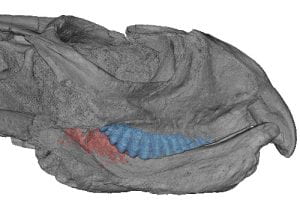 Bristol MSc student Thitiwoot Sethapanichsakul published the second paper from his MSc thesis, about the internal structure of tooth replacement in rhynchosaurs, a group of reptiles that walked the earth between 250-225 million years ago, in the Middle and early Late Triassic, before being replaced by the dinosaurs.
Bristol MSc student Thitiwoot Sethapanichsakul published the second paper from his MSc thesis, about the internal structure of tooth replacement in rhynchosaurs, a group of reptiles that walked the earth between 250-225 million years ago, in the Middle and early Late Triassic, before being replaced by the dinosaurs.
Rhynchosaurs are a little-understood group of roughly sheep-sized herbivorous reptiles that thrived during the Triassic Period, a time of generally warm climates and tough vegetation. They had batteries of teeth in the maxilla (blue) and mandible (red), and these replaced from the back of the jaws. In comparing a juvenile, an adult, and a very old adult, the researchers found that the whole mandible was deeply gouged by tooth wear in the very old adult.
“Comparing the sequence of fossils through their lifetime, we could see that as the animals aged, the area of the jaws under wear at any time moved backwards relative to the front of the skull, bringing new teeth and new bone into wear,” said Thitiwoot Sethapanichsakul who studied the jaws as part of his MSc in Palaeobiology. “Eventually, though, after a certain age – we’re not sure quite how many years – their growth slowed down and the area of wear was fixed and just got deeper and deeper. It’s like elephants today – they have a fixed number of teeth that come into use from the back, and after the age of seventy or so they’re on their last tooth, and then that’s that”.
The paper:
‘Unique dentition of rhynchosaurs and their two-phase success as herbivores in the Triassic’ By Sethapanichsakul, T., Coram, R.A. and Benton, M.J in Palaeontology. Doi: 10.1111/pala.12654

